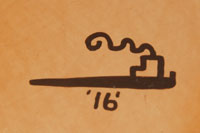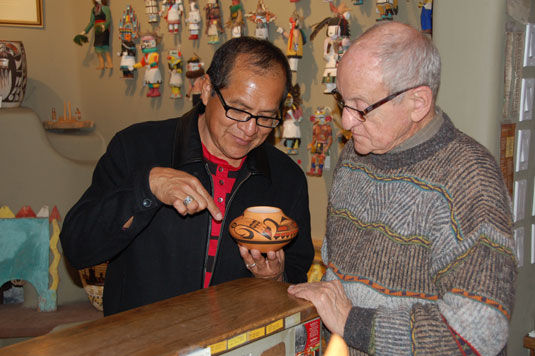Polacca Polychrome Inspired Contemporary Hopi Pottery Bowl by Mark Tahbo [SOLD]
+ Add to my watchlist Forward to Friend
- Category: Modern
- Origin: Hopi Pueblo, Hopituh Shi-nu-mu
- Medium: clay, pigment
- Size: 2-1/4” depth x 9-1/4” diameter
- Item # 25930 SOLD

Hopi potters were enchanted with pottery designs being unearthed at their prehistoric ancestral Sikyatki site in the 1890s. They began using designs from the Sikyatki Polychrome wares being discovered. Their modern reproductions of these designs have become known as Polacca Polychrome and they were primarily being made for sale to Thomas Keam who had a ready market for Sikyatki Polychrome wares as well as later pottery using the designs from those wares.
Hopi Pueblo potter Mark Tahbo mimicked those potters of more than a hundred years ago, who were mimicking those of almost a thousand years before their time. Just like the potters of the 1890s were reintroducing designs from the Sikyatki potters, Mark Tahbo reintroduced designs from the potters of the 1890s. He used designs from Polacca Polychrome pottery as his inspiration for some of his pottery.
This Polacca Polychrome Inspired Contemporary Hopi Bowl is a good example of a Mark Tahbo design influenced by a Polacca design. The layout is of a style from a circa 1860-1890 Polacca Polychrome bowl. The central square or diamond element anchors four cloud elements that spread to the outer edges of the bowl. The dark brown scallop row represents clouds, the zigzag elements below represent lightning and the cross hatched triangle below that represents rain. The spirals enclosing the storm pattern are lifted directly from Polacca Polychrome jars and were frequently used by Nampeyo of Hano in her designs.
The potters of the Sikyatki period were creative in design application, achieving some of the most beautiful pottery ever created from the Hopi region. The potters of the late 1890s reintroduced us to those magnificent designs from prehistory and now Mark Tahbo has brought those designs to our attention and shared his talent with us as an artist by using those designs as inspiration for creating designs of his own.
It is evident that Mark Tahbo was one of the most creative of the potters at Hopi of the time. He was not content to continue using the same design over and over, rather he constantly searched the literature for new and exciting thoughts. He used to exude with enthusiasm as he explained each piece to us. His pride in the completed product was obvious and he loved explaining each design element, where it came from, how he changed it and how proud he was of the results.
This is the first bowl we acquired from Mark Tabho. Mostly he made jars but the Polacca Polychrome bowl from the Keam Collection inspired him to make a bowl. We recommend that you take a few minutes and view our short video in which Mark discussed the bowl at the time he brought it to the gallery.
Mark Tahbo (b.1958) was a Hopi-Tewa and a member of the Tobacco Clan. He had been an active potter since 1978. He came from a long line of outstanding potters, the most famous of whom was his great-grandmother Grace Chapella. He was also the grandson of her daughter Alma Tahbo. His siblings were potters too. Grace Chapella, of course, is famous for living to 106 years and continuing to make pottery past her 100th birthday.
Condition: new
Provenance: this Polacca Polychrome Inspired Contemporary Hopi Pottery Bowl by Mark Tahbo is from the artist
Images of Mark Tahbo and signatures are by Adobe Gallery. ** If you discover credit omissions or have additional information to add, please let us know at Marketing@adobegallery.com.
Recommended Reading: America’s Great Lost Expedition—The Thomas Keam Collection of Hopi Pottery from the Second Hemenway Expedition, 1890-1894, by Wade and McChesney
Relative Links: Hopi-Tewa, Grace Chapella, Hopi Pueblo, Alma Tahbo, Pueblo Pottery, Nampeyo of Hano, Mark Tahbo, prehistoric pottery
- Category: Modern
- Origin: Hopi Pueblo, Hopituh Shi-nu-mu
- Medium: clay, pigment
- Size: 2-1/4” depth x 9-1/4” diameter
- Item # 25930 SOLD





